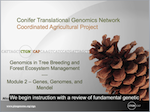Authors:
Nicholas Wheeler, Oregon State University; David Harry, Oregon State University; Heather L. Merk, The Ohio State University
Introduction
Most traits in forest trees are quantitatively inherited; that is, they are controlled by many genes, each of which controls a modest amount of the variance in that trait. A gene that controls some portion of the genetic variance of a phenotypic trait is called a quantitative trait locus, or QTL. It is possible to identify QTL and their relative location in the genome by placing them on genetic maps. This is done by demonstrating a statistically significant association between the quantitative trait phenotype and one or more genetic markers already located on a map. QTL mapping is a powerful tool for elucidating the genetic architecture of complex traits and provides a clearly defined approach for marker-assisted selection in applied breeding or natural environment settings. We will identify the key elements of QTL mapping and give some examples of how it has been done in forest trees. Additionally, we will reflect on some of the limitations of the QTL approach using pedigree crosses.
Module 9 — Mapping Quantitative Trait Loci (QTL)
See other Conifer Genomics Modules
You can also watch the video on YouTube.
References Cited
- Beavis, W. D. 1994. The power and deceit of QTL experiments: Lessons from comparative QTL studies. p. 250-266. In Proceedings 49th Annual Corn and Sorghum Industry Research Conference. American Seed Trade Association, Washington, DC.
- Brown, G. R., D. L. Bassoni, G. P. Gill, J. R. Fontana, N. C. Wheeler, R. A. Megraw, M. F. Davis, M. M. Sewell, G. A. Tuskan, and D. B. Neale. 2003. Identification of quantitative trait loci influencing wood property traits in loblolly pine (Pinus taeda L) III. QTL verification and candidate gene mapping. Genetics 164: 1537-1546.
- Doerge, R. W. 2002. Mapping and analysis of quantitative trait loci in experimental populations. Nature Reviews Genetics 3: 43-52.
- Flint J. and R. Mott. 2001. Finding the molecular basis of quantitative traits: Successes and pitfalls. Nature Reviews Genetics 2: 437-445.
- Flint, J, W. Valdar, S. Shifman, and R. Mott. 2005. Strategies for mapping and cloning quantitative trait genes in rodents. Nature Reviews Genetics 6: 271-286. (Available online at: http://dx.doi.org/10.1038/nrg1576) (verified 1 June 2011).
- Georges, M. 2007. Mapping, fine mapping, and molecular dissection of quantitative trait loci in domestic animals. Annual Review of Genomics and Human Genetics 8: 131-162. (Available online at: http://dx.doi.org/10.1146/annurev.genom.8.080706.092408) (verified 1 June 2011).
- Grattapaglia, D. 2007. Marker–assisted selection in Eucalyptus. p. 251-281. In E. P. Guimaraes, J. Ruane, B. D. Scherf, A. Sonnino, and J. D. Dargie (ed.) Marker assisted selection: current status and future perspectives in crops, livestock, forestry and fish. Food and Agriculture Organization of the United Nations, Rome, Italy.
- Jermstad, K. D., D. L. Bassoni, K. S. Jech, N. C. Wheeler, and D. B. Neale. 2001a. Mapping of QTL controlling adaptive traits in coastal Douglas-fir: I. Timing of vegetative bud flush. Theoretical and Applied Genetics 102:1142-1151.
- Jermstad K. D, D. L. Bassoni, N. C. Wheeler, T. S. Anekonda, S. N. Aitken, W. T. Adams, and D. B. Neale. 2001b. Mapping of quantitative trait loci controlling adaptive traits in coastal Douglas-fir. II. Spring and fall cold-hardiness. Theoretical and Applied Genetics 102: 1152-1158.
- Jermstad, K. D., D. L. Bassoni, K. S. Jech, G. A. Ritchie, N. C. Wheeler, and D. B. Neale. 2003. Mapping of quantitative trait loci controlling adaptive traits in coastal Douglas-fir. III. QTL by environment interactions and verification. Genetics 165: 1489-1506.
- Price, A. H. 2006. Believe it or not QTLs are accurate! Trends in Plant Sciences 11: 213-216. (Available online at: http://dx.doi.org/10.1016/j.tplants.2006.03.006) (verified 1 June 2011).
- Wheeler, N. C., K. D. Jermstad, K. Krutovsky, S. N. Aitken, G. T. Howe, J. Krakowski, and D. B. Neale. 2005. Mapping of quantitative trait loci controlling adaptive traits in coastal Douglas-fir. IV. Cold-hardiness QTL verification and candidate gene mapping. Molecular Breeding 15: 145-156. (Available online at: http://dx.doi.org/10.1007/s11032-004-3978-9) (verified 1 June 2011).
- White, T. L, W. T. Adams, and D. B. Neale. 2007. Forest genetics. CAB International, Wallingford, United Kingdom. Available online at: http://bookshop.cabi.org/?page=2633&pid=2043&site=191 (verified 1 June 2011).
External Links
- Basten, C., B. S. Weir, and Z. B. Zeng. QTL cartographer [Online]. Statistical Genetics & Bioinformatics, NC State University. Available at: http://statgen.ncsu.edu/qtlcart/manual/ (verified 1 June 2011).
- Index of ftp/distribution/software/mapmaker3 [Online]. Broad Institute. Available at: http://www.broadinstitute.org/ftp/distribution/software/mapmaker3/ (verified 1 June 2011).
- GridQTL [Online]. Available at: http://www.gridqtl.org.uk/ (verified 1 June 2011).
Cite This Learning Module
- Wheeler, N., and D. Harry. Mapping quantitative trait loci (QTL) [Online Learning Module]. Genomics in Tree Breeding and Forest Ecosystem Management, Conifer Translational Genomics Network. eXtension Foundation. Available at: https://plant-breeding-genomics.extension.org/mapping-quantitative-trait-loci-qtl:-conifer-genomics-module-9/ (verified April 22, 2013).
Author Contributions
- Nicholas Wheeler and David Harry developed the learning module content.
- Heather Merk developed the webpage.
Funding Statement
Support for the Conifer Translational Genomics Network project and the development of the teaching modules hosted here was provided by the USDA/NRI CSREES Coordinated Agricultural Project (CAP) Award # 2007-55300-18603, the USDA/NIFA AFRI Applied Plant Genomics CAP Award #2009-85606-05680 and the USDA Forest Service. Development of this page was supported in part by the National Institute of Food and Agriculture (NIFA) Solanaceae Coordinated Agricultural Project, agreement 2009-85606-05673, administered by Michigan State University. Any opinions, findings, conclusions, or recommendations expressed in this publication are those of the author(s) and do not necessarily reflect the view of the United States Department of Agriculture.
Attachments:
Mapping_QTL.pdf (2.21 MB)
PBGworks 1107

